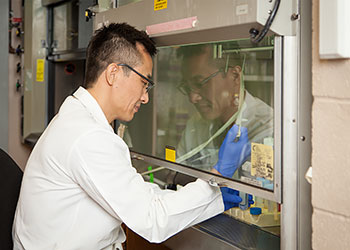Offers a New Target for Drug Design
A research group, headed by Zhang ‘John’ Weihua, associate professor of biology in the College of Natural Sciences and Mathematics at the University of Houston, discovered a mechanism by which the epidermal growth factor receptor (EGFR) is activated in the absence of ligands, which are extracellular signals. These findings were published in the journal Oncotarget.

Weihua’s research findings of an alternative activation mechanism for EGFR was published
in the journal Oncotarget.“I think blocking this alternative mechanism of EGFR activation has the potential
of being an effective therapy for many types of cancers,” Weihua said.
EGFR – a Key Player in Progression of Many Cancers
Known to play a key role in the progression of many types of cancer, EGFR is a type of protein, called a receptor tyrosine kinase, which acts as a mediator to stimulate cell growth. Although blocking EGFR tyrosine kinase activity works for some cancer patients, for many others these treatments don’t work. Even when patients respond well, there is a high risk that over time, the tumor will develop resistance to the drug.
“In terms of cancer treatment, we are facing challenges. Drugs that inhibit EGFR’s kinase and ligand-binding activity work for less than 20 percent of lung cancers and less than 10 percent of colon cancers. For many other cancers with EGFR overexpression, these drugs don’t work,” Weihua said.
Activation Usually Triggered by Signal from Outside Cell
EGFR is typically activated on the outside of the cell by the binding of a molecule, called a ligand. This action is the signal that can cross the ‘wall’ that is the cell membrane, triggering the protein’s kinase activity on the inside, leading to a signaling cascade that drives growth.
Most current drug therapies target EGFR’s ligand-binding and kinase activity. Drugs targeting the kinase activity have the limitation of only working for a mutated version of EGFR.
Finding Another Way to Activate EGFR
However, just as a single piece of equipment can work in many ways – just think of smart-phones, which can call, send texts, play music, and surf the Internet – EGFR can also act in other ways. The alternative ways in which EGFR can work are largely unknown, which is a question Weihua’s research group seeks to answer.
“Scientists have known for many years that EGFR can be activated in the absence of a ligand,” Weihua said. “We’ve just never known how.”
Weihua’s group has answered that long-standing question. What they discovered was that EGFR can be activated from the inside of the cell, in the absence of a ligand, by a process called palmitoylation, where a fatty acid is added to a specific amino acid, called Cysteine 797, on the inside region of EGFR. Cysteine 797 was recently shown by another research group to play a role in the ability of some tumors to acquire drug resistance.
Knowing this alternative mechanism – the palmitoylation of Cysteine 797 – by which EGFR is activated offers a different approach for designing effective cancer drugs.
This research was funded by the American Cancer Society, the Department of Defense Prostate Cancer Research Program and the National Institutes of Health.
- Rachel Fairbank, College of Natural Sciences and Mathematics